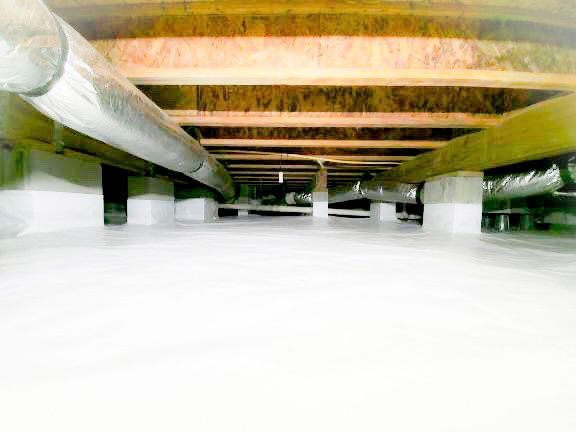The Role of Humidity Control in Preventing Mold Growth
Maintaining a healthy indoor environment involves more than just regular cleaning and maintenance—it requires careful attention to the factors that contribute to mold growth. Among these, indoor humidity levels play a pivotal role. This blog delves into the critical connection between humidity and mold, shedding light on how controlling moisture in the air can prevent mold infestations and protect both your home and health.
Mold thrives in damp conditions, making humidity a primary factor in its growth and proliferation. When indoor humidity levels rise above the ideal range of 30-50%, the likelihood of mold growth increases significantly. This is particularly true in areas prone to moisture, such as bathrooms, kitchens, basements, and attics. By understanding the relationship between humidity and mold, homeowners can take proactive steps to manage indoor moisture and reduce the risk of mold.
This blog will explore the science behind humidity and mold growth, explaining how excess moisture creates an ideal environment for mold spores to settle and expand. We will discuss practical strategies for monitoring and controlling indoor humidity, including the use of dehumidifiers, proper ventilation, and regular inspections. Additionally, we will highlight the health implications of mold exposure, emphasizing why it’s essential to maintain optimal humidity levels in your home.
Through detailed insights and practical advice, this blog aims to empower homeowners with the knowledge and tools needed to manage indoor humidity effectively. By doing so, you can create a safer, healthier living space, free from the persistent threat of mold.
Understanding Mold and Humidity
To effectively prevent and control mold growth in your home, it's essential to understand the relationship between mold and humidity. This section delves into the conditions mold needs to thrive and the optimal humidity levels for maintaining a mold-free environment.
How Mold Grows
Conditions Required for Mold Growth: Mold is a type of fungus that needs specific conditions to grow, primarily moisture, warmth, and organic materials:
- Moisture: Mold thrives in damp environments. Excess moisture from leaks, condensation, or high humidity creates the perfect breeding ground for mold spores.
- Warmth: Warm temperatures, generally between 77-86°F (25-30°C), are ideal for mold growth. However, mold can grow in a wide temperature range, making it a year-round concern.
- Organic Materials: Mold feeds on organic materials such as wood, paper, and fabrics. These materials provide the nutrients mold needs to multiply and spread.
Annotations will include detailed explanations and visual aids showing how these factors contribute to mold growth in various areas of the home.
Lifecycle of Mold Spores: Mold spores are microscopic particles that are ubiquitous in indoor and outdoor environments. They can remain dormant until they encounter favorable conditions. When exposed to moisture, spores absorb water and begin to grow, forming colonies that release more spores into the air. This lifecycle can rapidly expand mold presence in humid environments.
Annotations will provide a detailed breakdown of the mold lifecycle, including how spores travel and colonize new areas, with links to further reading on mold biology.
Optimal Humidity Levels for Homes
Ideal Indoor Humidity Range: Maintaining indoor humidity levels between 30-50% is crucial for inhibiting mold growth. Within this range:
- 30-50% Humidity: This range keeps moisture levels low enough to prevent mold spores from absorbing the water they need to grow.
- Below 30%: Humidity levels below 30% can lead to overly dry air, which might cause discomfort and respiratory issues, but it does inhibit mold growth.
- Above 50%: When humidity levels exceed 50%, the risk of mold growth increases significantly as the air provides sufficient moisture for mold spores to thrive.
Annotations will explain the science behind these humidity levels, providing tips on how to measure and maintain optimal humidity in different seasons.
Effects of Humidity Levels Outside the Ideal Range:
- High Humidity (>50%): Excess moisture can accumulate on surfaces, particularly in poorly ventilated areas, creating ideal conditions for mold growth. Common signs include condensation on windows, damp spots on walls, and a persistent musty smell.
- Low Humidity (<30%): While low humidity can prevent mold, it may cause other issues like dry skin, irritated respiratory passages, and increased static electricity.
Annotations will offer practical advice on how to adjust humidity levels using dehumidifiers, humidifiers, and ventilation techniques, along with real-life examples of humidity management.
Methods of Humidity Control
Controlling humidity is essential for preventing mold growth and maintaining a healthy indoor environment. This section outlines effective methods for humidity control, focusing on ventilation improvements and the use of dehumidifiers.
Ventilation Improvements
Importance of Proper Ventilation: Proper ventilation is crucial in high-moisture areas like kitchens, bathrooms, and basements. These areas are prone to moisture accumulation from cooking, bathing, and natural ground dampness. Good ventilation helps to disperse moisture-laden air, reducing the chances of mold growth.
Annotations will include diagrams showing typical problem areas in these rooms and the impact of poor versus effective ventilation on humidity levels.
Tips for Improving Ventilation:
- Using Exhaust Fans: Install and regularly use exhaust fans in kitchens and bathrooms to remove moist air. Ensure fans are vented to the outside rather than into the attic or crawl space.
- Opening Windows: When weather permits, open windows to allow fresh air to circulate, especially during activities that generate moisture.
- Air Conditioning Units: Ensure your air conditioning units are properly sized and maintained. An undersized unit may not adequately dehumidify the air, while an oversized unit may cool too quickly without removing sufficient moisture.
Annotations will provide step-by-step instructions for proper fan installation, maintenance tips for air conditioning units, and practical advice for using natural ventilation effectively.
Use of Dehumidifiers
Selecting and Using Dehumidifiers: Dehumidifiers are highly effective at reducing humidity levels in parts of the home prone to high moisture, such as basements and laundry rooms. Choosing the right dehumidifier depends on the size of the area and the level of humidity.
Annotations will include a guide on different types of dehumidifiers (e.g., refrigerant vs. desiccant), their ideal applications, and how to calculate the appropriate capacity for your needs.
Best Practices for Maintaining Dehumidifiers: To ensure dehumidifiers are effective in moisture control, regular maintenance is key:
- Emptying and Cleaning the Reservoir: Regularly empty and clean the water reservoir to prevent mold and bacteria buildup.
- Cleaning the Filter: Clean or replace the filter as per the manufacturer’s instructions to maintain airflow and efficiency.
- Positioning: Place dehumidifiers in central locations within the room for optimal air circulation. Avoid placing them against walls or furniture.
Annotations will provide maintenance schedules, troubleshooting tips for common issues, and advice on optimizing dehumidifier performance.
Monitoring Humidity Levels
Consistent monitoring of indoor humidity levels is essential for preventing mold growth and maintaining a healthy living environment. This section discusses the tools and techniques for measuring humidity and offers guidelines for regular checks and adjustments to keep your home within the ideal humidity range.
Tools for Measuring Humidity
Introduction to Hygrometers: Hygrometers are devices used to measure the moisture content in the air, providing a precise reading of indoor humidity levels. They come in various types, including digital and analog models, each offering different features such as temperature readings and data logging capabilities.
Annotations will explain the basic operation of hygrometers, their importance in mold prevention, and comparisons of different models to help homeowners choose the best option for their needs.
Recommendations for Placing Humidity Sensors: To get accurate readings, it's important to place humidity sensors in strategic locations around your home:
- High-Moisture Areas: Bathrooms, kitchens, and basements are prime spots for monitoring humidity due to their high moisture levels.
- Living Spaces: Place sensors in living rooms, bedrooms, and other frequently used areas to ensure the overall indoor environment remains healthy.
- Multiple Locations: Using multiple sensors can provide a comprehensive view of humidity levels throughout your home, helping to identify problem areas more effectively.
Annotations will provide diagrams and tips on optimal sensor placement, ensuring homeowners get accurate and useful readings from their hygrometers.
Regular Checks and Adjustments
Routine for Checking Humidity Levels: Regularly checking indoor humidity is crucial for maintaining optimal conditions:
- Daily Monitoring: Check humidity levels daily, especially during high-moisture activities like cooking or showering.
- Seasonal Adjustments: Be particularly vigilant during seasonal changes, as outdoor weather can significantly impact indoor humidity.
Annotations will include a suggested routine for daily and seasonal checks, as well as tips on recording and tracking humidity levels over time for better management.
Responding to Fluctuations in Humidity: Indoor humidity levels can fluctuate due to changes in outdoor weather or various home activities. Here’s how to manage these fluctuations:
- Increasing Humidity: If levels drop below 30%, consider using humidifiers or placing water basins near heat sources to add moisture to the air.
- Decreasing Humidity: For levels above 50%, use dehumidifiers, increase ventilation, and ensure air conditioning units are functioning correctly.
Annotations will offer step-by-step guides on adjusting humidity levels, with practical solutions for both increasing and decreasing indoor moisture content. Additionally, they will provide troubleshooting tips for common humidity-related issues and advice on maintaining a balanced indoor environment.
Addressing High Humidity at Its Source
Effectively controlling indoor humidity starts with identifying and addressing the sources of excess moisture. This section explores common causes of indoor moisture and provides practical solutions to prevent humidity from reaching levels that encourage mold growth. Additionally, it covers building and renovation considerations to manage moisture effectively.
Identifying Sources of Excess Moisture
Common Sources of Indoor Moisture: Indoor humidity can rise due to various sources of excess moisture. Identifying and addressing these sources is crucial for maintaining a healthy indoor environment:
- Leaking Pipes: Water leaks from pipes can significantly increase indoor humidity. Regularly inspect plumbing for leaks and fix them promptly.
- Condensation: Condensation on windows, walls, and pipes can indicate high indoor humidity. This often occurs in areas with poor ventilation or insulation.
- Poor Drainage: Water pooling around the foundation due to poor drainage can seep into basements and crawl spaces, raising indoor moisture levels.
Annotations will provide visual aids and diagrams to help homeowners identify these common sources of moisture in their homes, along with tips for regular inspections.
Steps to Address These Issues: To prevent humidity from reaching mold-conducive levels, it's essential to address the root causes of excess moisture:
- Fixing Leaks: Repair leaking pipes and ensure plumbing is in good condition. Use waterproof sealants where necessary.
- Improving Ventilation: Increase ventilation in areas prone to condensation by using exhaust fans and opening windows to promote air circulation.
- Enhancing Drainage: Ensure proper drainage around your home by maintaining gutters and downspouts, grading soil away from the foundation, and installing French drains if necessary.
Annotations will include detailed guides on how to carry out these fixes, with practical advice and recommended tools for each task.
Building and Renovation Considerations
Materials and Building Techniques for Moisture Management: When constructing new buildings or renovating existing ones, consider materials and techniques that help manage moisture:
- Vapor Barriers: Install vapor barriers in walls, floors, and ceilings to prevent moisture from passing through and condensing inside building materials.
- Moisture-Resistant Materials: Use moisture-resistant drywall, paint, and insulation in areas prone to high humidity, such as bathrooms and basements.
- Proper Sealing: Ensure windows and doors are properly sealed to prevent moisture ingress. Use weatherstripping and caulk to seal gaps and cracks.
Annotations will provide recommendations for moisture-resistant products and materials, explaining their benefits and applications in different parts of the home.
Importance of Vapor Barriers, Properly Sealed Windows, and Moisture-Resistant Materials: Using these building techniques and materials can significantly reduce the risk of mold growth by controlling indoor moisture levels:
- Vapor Barriers: Help keep moisture out of walls and floors, reducing the risk of mold and structural damage.
- Sealed Windows: Prevent rain and humid air from entering the home, maintaining a consistent indoor humidity level.
- Moisture-Resistant Materials: Are designed to withstand high humidity without degrading, providing long-term protection against mold.
Annotations will include case studies or examples of successful moisture management in homes, highlighting the long-term benefits of these building practices.
Benefits of Humidity Control Beyond Mold Prevention
Controlling indoor humidity offers a host of benefits beyond simply preventing mold growth. This section explores the positive impacts of humidity control on health and home integrity, emphasizing its importance for overall well-being and property preservation.
Health Benefits
Respiratory Health and Comfort: Maintaining optimal indoor humidity levels (30-50%) can significantly improve respiratory health and overall comfort. High humidity can exacerbate respiratory issues by promoting the growth of mold, bacteria, and dust mites, which are common allergens and irritants. By controlling humidity:
- Reduced Allergens: Lower humidity levels help reduce the presence of dust mites and mold spores, two major indoor allergens.
- Improved Air Quality: Proper humidity levels can improve indoor air quality, making it easier to breathe and reducing the risk of respiratory infections and conditions such as asthma and allergies.
Annotations will include links to medical research on the impact of humidity on respiratory health and tips on maintaining indoor air quality.
Reduction in Other Pests: Humidity control also helps in reducing other household pests, particularly dust mites:
Dust Mites: Thrive in high humidity environments. By keeping humidity levels below 50%, their population can be significantly reduced, leading to fewer allergy symptoms and better indoor air quality.
Annotations will provide detailed explanations of how dust mites thrive in high humidity and the specific steps to minimize their presence through humidity control.
Protecting Home Integrity
Preserving Structural Integrity: Proper humidity control is crucial in preserving the structural integrity of a home:
- Preventing Wood Rot: Excess moisture can cause wood rot, weakening structural components such as beams, floors, and walls. By maintaining optimal humidity levels, the risk of wood rot is minimized.
- Avoiding Moisture-Related Damage: High humidity can lead to the deterioration of building materials like drywall, paint, and insulation. Keeping humidity in check helps preserve these materials, extending their lifespan.
Annotations will include examples of moisture-related damage in homes and case studies demonstrating the benefits of humidity control in preventing such issues.
Long-Term Savings: Effective humidity control can lead to significant long-term savings for homeowners:
- Avoiding Extensive Mold Remediation: By preventing mold growth, homeowners can avoid the high costs associated with professional mold remediation services.
- Reducing Home Repairs: Controlling humidity prevents moisture-related damage to the home’s structure and materials, reducing the need for frequent repairs and replacements.
Annotations will offer insights into the costs of mold remediation and home repairs due to moisture damage, providing a clear comparison of potential savings through proactive humidity control.
FAQs
Contact Lowcountry Crawlspaces Today!
Lowcountry Crawlspaces will do everything we can to ensure your experience with us is excellent.
Request A FREE Estimate
CHECKOUT RECENT POST



Schedule Your FREE Crawl Space Evaluation Today
There Is No Crawl Space Job We Can’t Fix!




